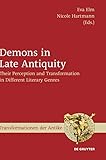Demons in Late Antiquity : Their Perception and Transformation in Different Literary Genres / ed. by Eva Elm, Nicole Hartmann.
Material type: TextSeries: Transformationen der Antike ; 54Publisher: Berlin ; Boston : De Gruyter, [2020]Copyright date: ©2020Description: 1 online resource (VI, 176 p.)Content type:
TextSeries: Transformationen der Antike ; 54Publisher: Berlin ; Boston : De Gruyter, [2020]Copyright date: ©2020Description: 1 online resource (VI, 176 p.)Content type: - 9783110626728
- 9783110630626
- 9783110632231
- BT975 .D456 2019
- online - DeGruyter
- Issued also in print.
| Item type | Current library | Call number | URL | Status | Notes | Barcode | |
|---|---|---|---|---|---|---|---|
 eBook
eBook
|
Biblioteca "Angelicum" Pont. Univ. S.Tommaso d'Aquino Nuvola online | online - DeGruyter (Browse shelf(Opens below)) | Online access | Not for loan (Accesso limitato) | Accesso per gli utenti autorizzati / Access for authorized users | (dgr)9783110632231 |
Frontmatter -- Contents -- Introduction -- 1. Demons and Disease -- 2. Disease and Healing in a Changing World. “Medical” Vocabulary and Exorcism in the Vetus Latina Luke -- 3. On Demons in Early Martyrology -- 4. Demons of the Underworld in the Christian Literature of Late Antiquity -- 5. Demons in Early Latin Hagiography -- 6. Hilarion and the Bactrian Camel. Demons and Genre in Jerome’s Life of Hilarion -- 7. The Ambiguity of the Devil. A Discourse-Linguistic Reading of Sulpicius Severus’ Vita Martini 21 and 24 -- 8. Demonic Speech in Hagiography and Hymnography -- Demons: An Epilogue -- About the Authors
restricted access online access with authorization star
http://purl.org/coar/access_right/c_16ec
Since the perception of demons in antiquity depended on particular cultural and religious milieus, the authors in this volume take into view various texts – ranging from amulets, spells, apocalypses, martyrdom literature to hagiography – and focus specifically on literary aspects of the transformation of demons and their contextualization. Are specific conceptions of demons characteristic for a certain genre or, rather, for particular religious contexts, so that they appear as topoi independent of genre? Do certain representations of demons prevail in pagan, Jewish and Christian circles alike, irrespective of religious background? How do notions of demons function in apocalypses, hymns, hagiographies or texts from healing procedures and what interdependencies of genre and social context can be traced? These questions are analysed from diverse disciplinary perspectives that offer some fresh and surprising answers.
The perception of demons in late antiquity was determined by the cultural and religious contexts. Therefore the authors of this volume take into consideration a wide variety of texts stemming from different religious milieus ranging from spells, apocalypses, martyrdom literature to hagiography and focus specifically on the literary aspects of the transformation of the demonic in this period of transition.
Issued also in print.
Mode of access: Internet via World Wide Web.
In English.
Description based on online resource; title from PDF title page (publisher's Web site, viewed 28. Feb 2023)


